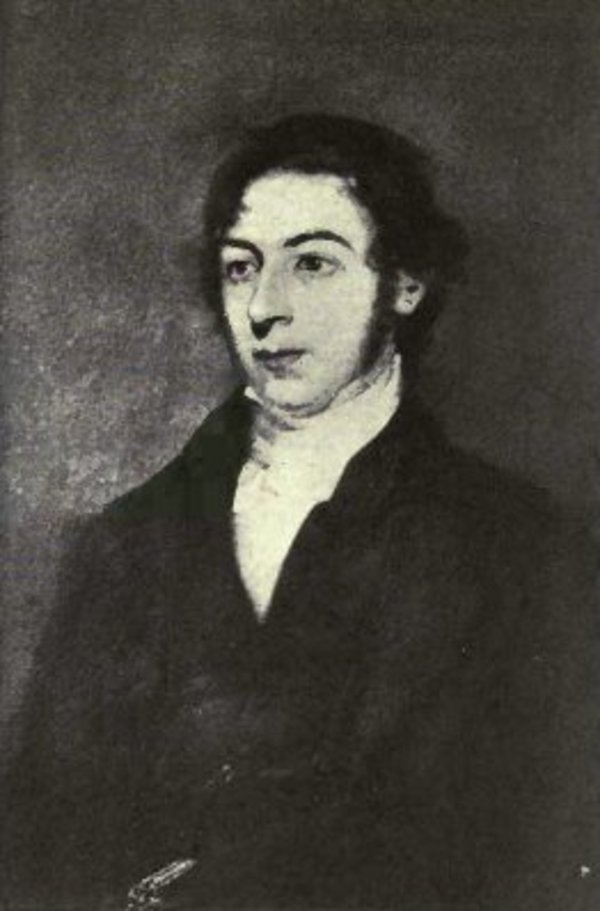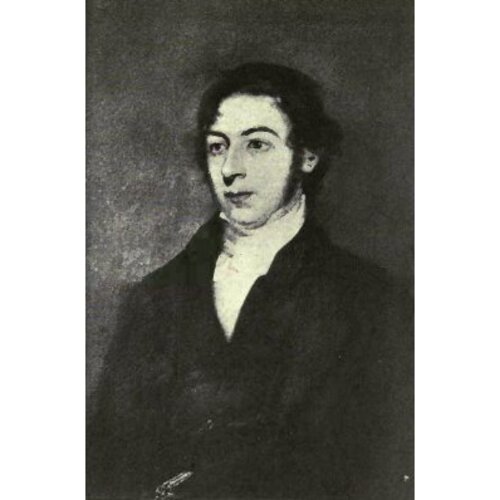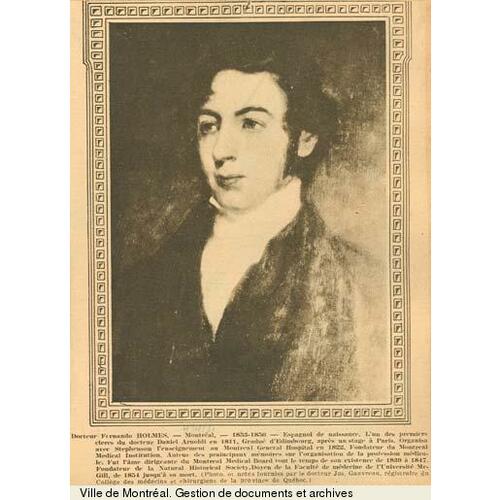
Source: Courtesy of Wikimedia Commons
HOLMES, ANDREW FERNANDO (Ferdinando), physician, professor, college administrator, author, and scientist; b. 17 March 1797 in Cadiz, Spain, second son of Thomas Holmes, a businessman, and Susanna Scott; m. Juliet Wadsworth, and they had three daughters and one son; d. 9 Oct. 1860 in Montreal.
Andrew Fernando Holmes was born at Cadiz because the vessel in which his parents and his brother, Benjamin*, sailed from the British Isles had been captured by a French frigate and taken to Spain as a prize. The family did not reach British North America until 1801, settling first at Quebec for a few years and then moving to Montreal.
Holmes received his preliminary education at the school of Alexander Skakel*. In 1811 he was articled to Dr Daniel Arnoldi* and five years later he received his licence from the Montreal board of medical examiners. At that period many men would have been satisfied with this qualification and would have immediately begun medical practice. Holmes set his sights higher. He went to Scotland, where he obtained his diploma from the Royal College of Surgeons of Edinburgh in 1818 and his md from the University of Edinburgh in 1819. His graduation thesis, in Latin, was entitled “De tetano.” After completing his studies, he visited London and Dublin, and spent a short time in Paris before returning to Lower Canada.
In 1819 Holmes entered into partnership for five years with his former instructor, Arnoldi, and then practised alone until his death in 1860. With the opening of the Montreal General Hospital in 1822, he joined its medical staff, a connection he retained for the rest of his life; he was a member of the active attending staff for more than 20 years and on retiring became a consultant. Holmes and his colleagues at the Montreal General Hospital wished to teach medicine as well as practise it. As early as 1822 Holmes was giving a course in chemistry at the home of Skakel, and Dr John Stephenson*, with whom he had studied in Great Britain, was lecturing on anatomy and physiology at the hospital. Not content with these informal arrangements, Holmes and Stephenson drew up a memorandum setting forth the arguments in favour of establishing a medical school. After approval by their colleagues at the hospital, the memorandum was sent to the governor, Lord Dalhousie [Ramsay*], together with a letter suggesting that the medical licensing body be remodelled to consist of the medical officers of the Montreal General Hospital. Dalhousie expressed his approval of both plans, thus giving the future staff of the medical school authority to license as well as teach their students (a situation which provoked criticism and eventually led to new legislation regulating medical licensing). The medical officers of the hospital rented a house on Rue Saint-Jacques near Place d’Armes and provided it with chemical apparatus, anatomical and pathological specimens, and a library. Opening its doors to students in the autumn of 1823, the Montreal Medical Institution was the first medical school established in Canada. Instruction was given both at the institution and at the Montreal General Hospital. Holmes taught chemistry, pharmacy, and botany, and was in charge of the library. The terms pharmacy and materia medica seem to have been used interchangeably; in 1826 he was described as professor of chemistry and materia medica.
The Montreal Medical Institution had applied for a royal charter in 1823 but its application was rejected by the Colonial Office in 1828 because it had no affiliation with an educational institution. The officers then approached McGill College which had obtained a royal charter in 1821 but, because of prolonged litigation over the bequest of James McGill*, existed only on paper. In 1829 the problem of erecting a university with more than a nominal existence was neatly solved by “engrafting” upon McGill College the flourishing Montreal Medical Institution, which then became the McGill College Medical Faculty. The medical staff of the institution, William Caldwell*, William Robertson*, Stephenson, and Holmes, became the founding members of the faculty with Robertson, the senior member, as official head.
Apart from bestowing the power to grant academic degrees, the change was, at first, little more than one of name. As the school grew, however, Holmes relinquished some of his earlier responsibilities and assumed more senior duties. Dr Archibald Hall* took over materia medica in 1835 and chemistry in 1842. In 1845 Dr Lactance Papineau relieved Holmes of the teaching of botany. In 1843 Holmes had been appointed professor of the principles and practice of medicine, succeeding Robertson, and he therefore became official head of the faculty with the title of secretary. In 1854 this title was changed to dean. Like his professorship, Holmes occupied the deanship until his death. He continued in charge of the library throughout his life and, in addition, donated his private library to the college.
The recollections of his students indicate that Holmes was a conscientious but not a brilliant teacher. His lectures were said to be too detailed and exhaustive to be attractive, his voice was weak, and his delivery was wanting in animation. But there is no doubt that his teaching was based on the most careful, even laborious, preparation and, as one of his former students recalled, every word was worthy of being noted.
Holmes’s medical work was by no means confined to university teaching and administration. As well as maintaining an active practice, he made a number of original contributions to medical journals on topics such as diseases of the heart (including a description of an unusual congenital malformation), gunshot wound of the heart, congenital malformation of the oesophagus and trachea, cholera, uterine tumour, obstruction of the vermiform appendix, jaundice, and the use of chloroform as an anaesthetic. He was one of the founders of the Montreal Medico-Chirurgical Society in 1843 and was its first president. He served as a member of the board of governors of the College of Physicians and Surgeons of Lower Canada and was elected to a three-year term as its president in 1853.
Holmes’s interests ranged far beyond medicine. As a chemist he confined himself to teaching by lectures and highly successful demonstrations, but as botanist, mineralogist, and geologist he did much more. From his early sojourn in Edinburgh he brought to Canada an extensive herbarium of plants and a large collection of minerals and geological specimens to which he added from sources in Canada and the United States. His collection of the flora of Montreal Island and vicinity is especially noteworthy. In the field of mineralogy his reputation was enhanced by the naming of a form of brittle mica after him. He had submitted specimens to Dr Thomas Thomson, Regius professor of chemistry at the University of Glasgow. Thomson wrote, “This mineral being obviously new, I have given it the name of Holmite as a small tribute to Dr. Holmes of Montreal, to whom I am indebted for so many new and curious minerals from Canada and the United States of America.” Unfortunately, the name did not last long. Shortly after Thomson’s paper was published, holmite was found to be identical with seybertite, which had already been described, and the name holmite was dropped. Another mineral specimen submitted by Holmes was a relatively rare feldspar collected near Bytown (Ottawa), which Thomson named bytownite. In 1856 Holmes’s collection of minerals was purchased by McGill and, at the same time, he presented it with his herbarium. Thus Holmes served McGill not only as a teacher and administrator, but also as a discriminating collector of plants and minerals. His outstanding contributions were recognized in 1859 when McGill awarded him an honorary lld.
In view of his wide and varied interests, it is not surprising to find that Holmes was a founding member of the Natural History Society of Montreal in 1827, and that he took an active part in all its work. He catalogued the minerals and geological specimens in the society’s cabinets and was a curator of its museum. From 1827 to 1836 he was corresponding secretary of the society, and then, from 1836 to 1841, its president.
Finally, Holmes was a devout supporter of the Church of England and a member of the Montreal Auxiliary Bible Society. An appreciation published after his death stated that “in every sense of the word he was a Christian gentleman” and this was his “most striking characteristic.”
Holmes’s death in 1860 was sudden and unexpected, and caused widespread dismay. The McGill medical faculty wore mourning for a month and their students erected a memorial tablet which is still on display at the university. In 1865 the school established the Holmes medal, awarded annually to the student graduating with the highest total marks in the different branches of the medical curriculum. It remains today as the senior award for scholastic achievement in the medical undergraduate program. A portrait of Holmes, painted in 1819 by Scottish artist John Watson (later Sir John Watson-Gordon), was presented to the medical faculty by Holmes’s daughter. It was destroyed by fire in 1907 but, using a photograph of the portrait as a model, Robert Harris* painted another, which now hangs in the medical sciences building of McGill University.
Andrew Fernando Holmes is the author of numerous articles on medicine published in the Trans. (Edinburgh) of the Medico-Chirurgical Soc. of Edinburgh in 1824, the New York Medical and Physical Journal in 1826, the Boston Medical and Surgical Journal in 1833, the Montreal Medical Gazette in 1844, the British American Journal of Medical and Physical Science (Montreal), 1 (1845–46), 2 (1846–47), 3 (1847–48), and 6 (1850–51), and the Medical Chronicle (Montreal), 2 (1854–55) and 3 (1855–56). His mineral collection, which was purchased by McGill College, is at the Redpath Museum (McGill Univ., Montreal), and his herbarium is part of that at Macdonald College in McGill University. James Barnston prepared a catalogue of the section of the herbarium that concerns the Montreal region, which was published as “Catalogue of Canadian plants, in the Holmes’ herbarium, in the cabinet of the University of McGill College,” Canadian Naturalist and Geologist . . . (Montreal), 4 (1859): 100–16.
ANQ-M, CE1-68, 13 oct. 1860. Arch. of the Mount Royal Cemetery Company (Outremont, Que.), Reg. of burials, 13 Oct. 1860. McGill Univ. Arch., McGill College Medical Faculty, minute-book, 1842–52; Montreal Medical Institution, minute-book, 1822–24. McGill Univ. Libraries, Blacker-Wood Library, Montreal Natural Hist. Soc. Arch. Univ. of McGill College, Faculty of Medicine, Annual announcement (Montreal), 1852–61. Montreal Gazette, 11 Oct. 1850. Borthwick, Hist. and biog. gazetteer. Morgan, Bibliotheca Canadensis; Sketches of celebrated Canadians, 485–86. Abbott, Hist. of medicine. S. B. Frost, McGill University: for the advancement of learning (2v., Montreal, 1980–84). Archibald Hall, A biographical sketch of the late A. F. Holmes, M.D., LL.D. including a summary history of medical department of McGill College (Montreal, 1860). R. P. Howard, A sketch of the late G. W. Campbell . . . being the introductory address of the fiftieth session of the medical faculty of McGill University (Montreal, 1882). H. E. MacDermot, A history of the Montreal General Hospital (Montreal, 1950). M. E. [S.] Abbott, “Andrew F. Holmes, M.D., LL.D., 1797–1860,” McGill Univ. Magazine (Montreal), 4 (1905): 176–81; “An historical sketch of the medical faculty of McGill University,” Montreal Medical Journal, 31 (1902): 561–672; “Early American medical schools: the faculty of medicine of McGill University,” Surgery, Gynecology and Obstetrics (Chicago), 60 (1935): 242–53. E. H. Bensley, “The Holmes medal,” McGill Medical Journal (Montreal), 34 (1965): 3–7; “The Holmes mineral collection,” Montreal General Hospital News, 27 (1983), no.1: 10. D. C. MacCallum, “Reminiscences of the Medical School of McGill University,” McGill Univ. Magazine, 2 (1903): 124–48. R. W. Quinn, “The four founders,” McGill Medical Undergraduate Journal (Montreal), 5 (May 1936): 5–11.
Cite This Article
Edward Horton Bensley, “HOLMES, ANDREW FERNANDO (Ferdinando),” in Dictionary of Canadian Biography, vol. 8, University of Toronto/Université Laval, 2003–, accessed November 18, 2024, https://www.biographi.ca/en/bio/holmes_andrew_fernando_8E.html.
The citation above shows the format for footnotes and endnotes according to the Chicago manual of style (16th edition). Information to be used in other citation formats:
| Permalink: | https://www.biographi.ca/en/bio/holmes_andrew_fernando_8E.html |
| Author of Article: | Edward Horton Bensley |
| Title of Article: | HOLMES, ANDREW FERNANDO (Ferdinando) |
| Publication Name: | Dictionary of Canadian Biography, vol. 8 |
| Publisher: | University of Toronto/Université Laval |
| Year of publication: | 1985 |
| Year of revision: | 1985 |
| Access Date: | November 18, 2024 |




